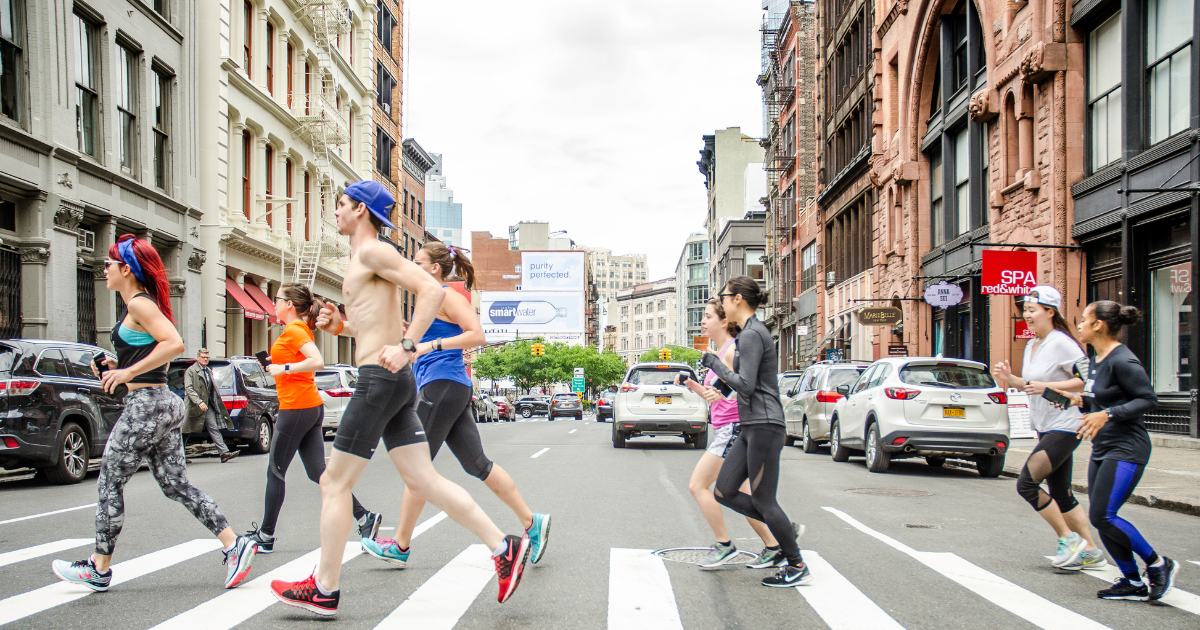RPE Scale Explained + Tips for Running by RPE
Photos by Marques Jackson Photography.
By Marnie Kunz,
Certified trainer and run coach
The RPE Scale is a way of estimating how hard you feel you’re exerting yourself during exercise. RPE stands for Rating of Perceived Exertion. This scale is based on a system developed by Swedish scientist Gunner Borg. The RPE method is helpful for determining your effort level when doing workouts ranging from track intervals to long runs. using the RPE scale can help you gauge your exercise intensity and dtermine when to dial up or down your physical activity. I often use RPE with clients I train in addition to other measures such as target running pace.
This overview will delve into the RPE scale, including what it is and how to use it to improve your running performance. Whether you’re training for your first 5K or a marathon, RPE offers a way to measure your progress and distinguish between hard and easy workouts.
Related Post: Benchmark Run 101: How to Measure Your Running Progress
What Is the RPE Scale?
The RPE scale is a tool to measure your effort level during exercise. The RPE scale can help runners assess when to slow down and when to speed up during your workouts. The most common RPE system ranges from 0 to 10, with 0 being no effort and 10 representing maximum effort.
RPE scales that we use today are derived from the work of Swedish scientist Gunner Borg in the 1960s. For his research, Borg used a rate of perceived exertion scale of 6 to 20 that correlates with a person’s heart rate. On the Borg scale, 6 represents no effort, and 20 is maximal effort level. The Borg RPE scale asks participants to rate their perception of exertion throughout a training session.
Today, the RPE system is often used by trainers and coaches to help guide athletes on how much they should exert themselves during workouts. For instance, if you’re doing a base run/easy training day, your coach may advise you to run at 4 or 5 on an RPE scale of 0 to 10. This means you’re staying in heart rate zones 2 and are exerting some effort but not feeling taxed.
Related Post: Running Essentials: The Base Run
RPE Chart for Runners
The RPE chart will help you determine what effort level you need to expend for different types of runs and workouts. When choosing your RPE, consider your breathing rate, heart rate, amount of sweating, and muscle fatigue. The scale is subjective so consider how you feel your physical workload is when you come up with an estimate of your RPE rating.
The use of RPE is one method that can give you a reliable measure of your effort level during a workout. Generally, you’ll want to stay at or below a RPE score of 5 for easy run days. You may get up to 9 or even a 10 for hard workouts like interval training or racing.
Here are some guidelines for running by RPE:
0: No exertion, resting.
1: Very light, slow movements such as strolling.
2-3: Fast walking or light running. You can maintain a conversation.
4-5: Moderate. Can hold a conversation. Your regular, relaxed pace base run (or Zone 2 run) pace.
6: Slightly hard. Can talk in short sentences. Half marathon race pace.
7: Tempo run pace, comfortably hard. You could maintain this pace with effort. 10K race pace.
8: Vigorous, hard to say more than a few words. 5K race pace.
9: Very hard. Interval pace for 400 meters or similar distances.
10: Maximum effort, highest possible. An all-out sprint. You can sustain for no more than 30 seconds.
Related Post: How Progressive Overload Can Improve Your Running
RPE and the Talk Test
The RPE system can also be used with the popular talk test for measuring exertion during aerobic workouts. According to the National Academy of Sports Medicine, the talk test correlates with the following RPE numbers:
RPE 1-4: You can easily hold a conversation.
RPE 5-6: Moderate intensity. You can still talk but is breathing a little harder.
RPE 8-9: High intensity. You are breathing hard and are barely able to talk.
The talk test and RPE are both based on how you feel while working out and are excellent ways to gauge when you need to push the pace and when to slow down during workouts.
Benefits of RPE for Runners
The RPE scale offers a way to assess your workout based on how you feel. Although it sounds simple, the system works surprisingly well. It also helps you to get in touch with how you feel during your workouts, making you more in tune with your body’s needs. For instance, if you feel like you’re at maximal effort but are running at a pace that is not very fast for you, this can tell you that your body needs rest. You may be overtraining.
Here are some of the benefits of running by perceived exertion:
Less reliance on expensive tech gadgets. This is especially helpful if your watch dies, you’re running in areas with poor GPS, or you prefer to run without devices. Many people don't have a tool to accurately measure HR (heart rate) during training, and a RPE score is something everyone can use. RPE does not require any special equipment, so you can focus on your run without having to constantly check your watch or phone.
Personalized training. RPE is subjective, so it can be tailored to your fitness level and needs. This means you can focus on running at the right intensity for you, regardless of your pace or heart rate.
More adaptable training. RPE can be used to adjust your workouts based on external factors such as weather conditions, terrain, or fatigue. This makes it a more flexible and versatile training tool than pace or heart rate. Adapting your training can also reduce your risk of injury and help you switch to low-intensity workouts when your body feels run down.
Improved body awareness. As you become more familiar with your RPE scale, you will learn to listen to your body and understand its limits. This can help you avoid overtraining and injury.
More enjoyable running. When you're running at the right intensity for you, you are more likely to enjoy your runs and stick with your training.
FAQs
What is 7 on the RPE scale?
RPE 7 is a moderate-hard effort. It is a level of exertion where you can still maintain good technique and form, but you are breathing hard, and your heart rate is elevated. RPE 7 is a good intensity for tempo runs, interval workouts, and other workouts that improve speed and endurance. It is also a good intensity for workouts that are meant to be challenging but sustainable.
How do you measure your RPE?
Choose an RPE scale to measure your RPE for running (1 to 10 is easiest to use). Then, rate your perceived exertion. While running, pay attention to how hard you are feeling. Consider your breathing, heart rate, muscle fatigue, and overall exertion level. Assign a number to your perceived exertion on the scale you have chosen. Adjust your pace as needed. If your RPE is too high or too low, adjust your speed to go faster or slower. The goal is to stay within your desired RPE range for the entire workout.
How can you use RPE for running?
RPE can help you plan your workouts and set targets for easy, medium, and hard days. RPE can be used to make sure you are staying within your desired intensity range during a workout. For example, if you feel an RPE of 9 during your easy run, you know you need to slow down. RPE can be used to track your overall training load and identify signs of overtraining. For example, if you consistently run at high RPEs, you may be at risk of overtraining. RPE can also be used to tailor your training to your individual fitness level and needs. For example, if you are new to running, start with easier runs and gradually increase your intensity as you improve your fitness level.
How can you use RPE for resistance training?
For strength training, you can set goal RPE scores for your workouts. If you'refocused on building muscle endurance, for instance, settinga lower RPE target will help you keep your resistance exercise within a lower intensityrange.
Tips for Running with RPE
Here are some tips for using RPE for your running program:
Start by setting a goal RPE number for your workout.
During the workout, focus on maintaining a consistent pace and breathing pattern.
Periodically check your RPE to ensure you stay within your desired range. If your RPE gets too high for your prescribed workout, reduce your repetitions or take a longer rest to ease back into your target zone.
If you start to feel too tired or your RPE is too high, take a short break or slow down. Prevention can help reduce your risk of injuries by paying attention to your body sensations.
With practice, you can use RPE to follow a running program that fits your needs and training conditions. If you need a training program that uses RPE and target pace goals, head to our Training Center for help.
Have you tried training with RPE? Tag @Runstreet on Instagram and share your workout to get cheered on. Happy running to you!😊
Related Posts: How to Do a Tempo Run and Get Faster, What Is a Good VO2 Max? How to Improve Yours to Run Faster, What Is Overtraining and How to Avoid It
Marnie Kunz is a NASM-certified trainer and USATF- and RRCA-certified running coach, dog lover, Akita mom, and writer based in Brooklyn, NY.




